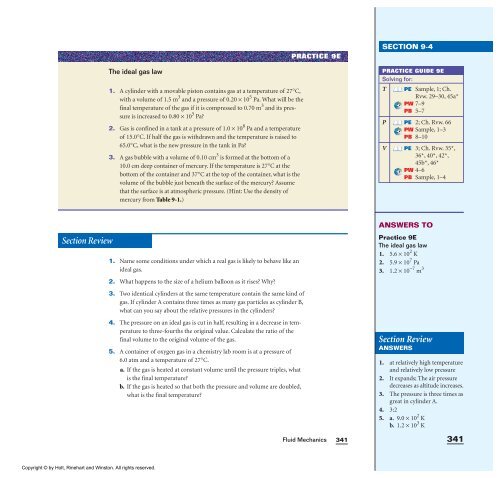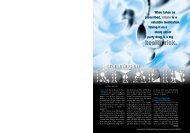You also want an ePaper? Increase the reach of your titles
YUMPU automatically turns print PDFs into web optimized ePapers that Google loves.
Section Review<br />
The ideal gas law<br />
Copyright © by Holt, Rinehart and Winston. All rights reserved.<br />
1. A cylinder <strong>with</strong> a movable piston contains gas at a temperature of 27°C,<br />
<strong>with</strong> a volume of 1.5 m 3 and a pressure of 0.20 × 10 5 Pa. What will be the<br />
final temperature of the gas if it is compressed to 0.70 m 3 and its pressure<br />
is increased to 0.80 × 10 5 Pa?<br />
2. Gas is confined in a tank at a pressure of 1.0 × 10 8 Pa and a temperature<br />
of 15.0°C. If half the gas is <strong>with</strong>drawn and the temperature is raised to<br />
65.0°C, what is the new pressure in the tank in Pa?<br />
3. A gas bubble <strong>with</strong> a volume of 0.10 cm 3 is formed at the bottom of a<br />
10.0 cm deep container of mercury. If the temperature is 27°C at the<br />
bottom of the container and 37°C at the top of the container, what is the<br />
volume of the bubble just beneath the surface of the mercury? Assume<br />
that the surface is at atmospheric pressure. (Hint: Use the density of<br />
mercury from Table 9-1.)<br />
1. Name some conditions under which a real gas is likely to behave like an<br />
ideal gas.<br />
2. What happens to the size of a helium balloon as it rises? Why?<br />
3. Two identical cylinders at the same temperature contain the same kind of<br />
gas. If cylinder A contains three times as many gas particles as cylinder B,<br />
what can you say about the relative pressures in the cylinders?<br />
4. The pressure on an ideal gas is cut in half, resulting in a decrease in temperature<br />
to three-fourths the original value. Calculate the ratio of the<br />
final volume to the original volume of the gas.<br />
5. A container of oxygen gas in a chemistry lab room is at a pressure of<br />
6.0 atm and a temperature of 27°C.<br />
a. If the gas is heated at constant volume until the pressure triples, what<br />
is the final temperature?<br />
b. If the gas is heated so that both the pressure and volume are doubled,<br />
what is the final temperature?<br />
PRACTICE 9E<br />
<strong>Fluid</strong> <strong>Mechanics</strong><br />
341<br />
SECTION 9-4<br />
PRACTICE GUIDE 9E<br />
Solving for:<br />
T PE Sample, 1; Ch.<br />
Rvw. 29–30, 45a*<br />
PW 7–9<br />
PB 5–7<br />
P PE 2; Ch. Rvw. 66<br />
PW Sample, 1–3<br />
PB 8–10<br />
V PE 3; Ch. Rvw. 35*,<br />
36*, 40*, 42*,<br />
45b*, 46*<br />
PW 4–6<br />
PB Sample, 1–4<br />
ANSWERS TO<br />
Practice 9E<br />
The ideal gas law<br />
1. 5.6 × 10 2 K<br />
2. 5.9 × 10 7 Pa<br />
3. 1.2 × 10 −7 m 3<br />
Section Review<br />
ANSWERS<br />
1. at relatively high temperature<br />
and relatively low pressure<br />
2. It expands; The air pressure<br />
decreases as altitude increases.<br />
3. The pressure is three times as<br />
great in cylinder A.<br />
4. 3:2<br />
5. a. 9.0 × 10 2 K<br />
b. 1.2 × 10 3 K<br />
341
















